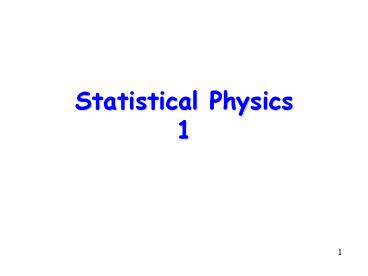Statistical Physics 1 PowerPoint PPT Presentation
1 / 18
Title: Statistical Physics 1
1
Statistical Physics 1
2
Topics
- Introduction
- The Boltzmann Distribution
- The Maxwell Distribution
- Summary
3
Introduction
- We believe we now have the basic laws that, in
principle, can be used to predict the detailed
behavior of an arbitrarily large assembly of
atoms and molecules - But even a tiny piece of matter consists of
millions of atoms - In practice, the complexity of the calculation is
far beyond the capability of any conceivable
computer and we need a different approach
4
Introduction
- Happily, for most applications we are not
interested in the precise behavior of each atom,
but only the collective behavior of the assembly,
which can be described with only a few variables,
such as temperature, pressure and volume - Statistical physics is the study of the
collective behavior of large assemblies of atoms
and molecules using probabilistic reasoning
5
The Boltzmann Distribution
The Austrian physicist Boltzmann asked the
following question in an assembly of atoms,
what is the probability that an atom has total
energy between E and EdE? His answer
where
Ludwig Boltzmann 1844 - 1906
6
The Boltzmann Distribution
is called the Boltzmann distribution, e-E/kT is
the Boltzmann factor and k 8.617 x 10-5
eV/K is the Boltzmann constant
The Boltzmann distribution applies to identical,
but distinguishable particles
Ludwig Boltzmann 1844 - 1906
7
The Boltzmann Distribution
The number of particles with energy E is given by
where g(E) is the statistical weight, i.e.,
the number of states with energy E. However, in
classical physics the energy is continuous so we
must replace g(E) by g(E)dE, which is the number
of states with energy between E and E dE. g(E)
is then referred to as the density of states.
8
The Boltzmann Distribution
Example 8-1 The Law of Atmospheres
Classically, the total energy of a gas
molecule of mass m, near the Earths surface, is
where z is the vertical distance above
the ground
z
Wanted the fraction of particles between z and
zdz
So we can write
9
The Boltzmann Distribution
Example 8-1 The Law of Atmospheres
A basic rule of probability is sum, or
integrate, over quantities whose values are
either unknown or not of interest. We are
interested only in z. After integrating the
Boltzmann distribution with respect to p we get
z
10
The Boltzmann Distribution
Example 8-1 The Law of Atmospheres
The fraction of molecules between z and z dz is
z
At T 300K, the ratio of the fraction at z
1000 m to that at z 0 m is just fB(1000) /
fB(0) 0.893
11
The Boltzmann Distribution
Example 8-2 H Atoms in First Excited State
At temperature T, the atoms of a gas will occupy
different energy levels. For hydrogen, the
energy difference E2 - E1 between the 1st excited
state and the ground state is 10.2 eV. What is
the ratio of the number of atoms in the 1st
excited state to the number in the ground state
at T 5800 K (the temperature of the Suns
surface)?
12
The Boltzmann Distribution
- Example 8-2
- Number of atoms in state E
- Ratio of number of atoms in E2 and E1
13
The Boltzmann Distribution
- Example 8-2
- Ratio of statistical weights. The degeneracy for
each orbital quantum number l is given by 2l1.
For the ground state of hydrogen, l 0, which
gives 1. For the 1st excited state l 0 and l
1, which gives 4. But for each of these states
the electron has 2 spin states. So we have g1 2
and g2 8. So
14
The Boltzmann Distribution
- Example 8-2
- 4. For T 5800 K (kT 0.5 and DE E2-E1
10.2 eV) we have
Even at the Suns surface there are relatively
few atoms in the 1st excited state. This
is because the energy gap DE gtgt kT
15
The Maxwell Distribution
An important application of the
Boltzmann distribution is the distribution of
molecular speeds v in a gas of N molecules
This distribution, in fact, was derived by James
Clerk Maxwell before Boltzmanns work. But it is
an important (and famous) special case.
16
The Maxwell Distribution
Most probable Average RMS
Different summaries of the molecular speed
computed from the Maxwell distribution
17
The Maxwell Distribution
Example The average speed of a nitrogen
molecule at T 300 K is given by
With k 1.39 x 10-23 J/K and m 4.68 x 10-26
kg one gets ltvgt 475 m/s 1700 km/h
18
Summary
- Statistical physics is the study of the
collective behavior of large assemblies of
particles - Ludwig Boltzmann derived the following energy
distribution for identical, but distinguishable,
particles - The Maxwell distribution of molecular speeds is a
famous application of Boltzmanns general formula

